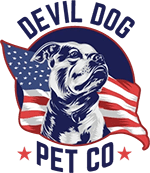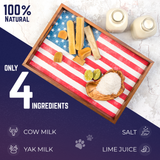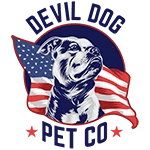Key Takeaways
- Your dog's esophagus is a muscular tube that transports food from the mouth to the stomach in seconds.
- Malfunction of the esophagus can lead to serious issues like regurgitation, weight loss, and aspiration pneumonia.
- Understanding the anatomy of the esophagus is crucial for preventing choking emergencies.
- Recognizing esophageal problems early can help ensure your dog receives immediate veterinary care.
Table of Contents
- The Canine Esophagus: Your Dog's Critical Food Highway
- The Three-Layer Esophageal Wall: Built for Precision
- Normal Esophageal Function: The Four-Phase Swallowing Sequence
- Five Major Esophageal Disorders: Recognition at a Glance
- Common Esophageal Disorders: The Big Five Emergencies
- Megaesophagus: Managing the Dilated Reality
- Esophageal Strictures and Obstruction: When Passage Narrows
- Chew Safety and Esophageal Health: A Devil Dog Perspective
- Esophagitis and Reflux: Chemical Damage Prevention
- Strategic Chew Selection by Esophageal Risk
- Emergency Recognition: When Minutes Matter
The Canine Esophagus: Your Dog's Critical Food Highway
Your dog's esophagus of dog is a muscular superhighway, 20–35 cm of precision tubing designed to move food from mouth to stomach in seconds. When this system fails, regurgitation, weight loss, and life-threatening aspiration pneumonia follow. Understanding esophageal anatomy isn't veterinary school trivia, it's the foundation for preventing choking emergencies and recognizing when your dog needs immediate care.
The esophagus functions as an active transport tube, not a passive conduit. Its three-layer muscular wall coordinates complex swallowing sequences that can be disrupted by oversized chews, genetic disorders, or inflammatory disease. This guide breaks down what every dog owner needs to know about esophageal health, from normal anatomy to emergency recognition.
We'll also examine how chew selection directly impacts esophageal safety, because the difference between a properly sized antler and a choking hazard often comes down to understanding your dog's individual anatomy and swallowing mechanics.
For dogs that need a safer, softer option, consider the 12" Ultra Thick Bully Stick - 3pk as a premium chew choice designed to minimize esophageal risk.
The Three-Layer Esophageal Wall: Built for Precision

The canine esophageal wall consists of three distinct layers, each serving a critical function in safe food transport. The inner mucosa features columnar epithelium with longitudinal folds called rugae that allow stretch accommodation. The middle submucosa contains blood vessels and nerve networks that coordinate muscular contractions.
The outer muscular layer reveals why chew size matters so critically. The upper third contains striated muscle under voluntary control, while the lower two-thirds feature smooth muscle operating purely on reflex. This anatomical split explains why dogs can sometimes cough up objects lodged in the upper esophagus of dog, but items stuck in the lower section often require surgical removal.
For more on the safety of antlers and how they interact with your dog's anatomy, read are antlers for dogs a good idea.
The Two Gatekeepers: Upper and Lower Esophageal Sphincters
The upper esophageal sphincter (UES) sits at the C3-C4 vertebra level and must relax precisely to initiate swallowing. When this cricopharyngeal muscle malfunctions, dogs develop gagging and aspiration risks. The lower esophageal sphincter (LES) at the gastroesophageal junction normally stays closed to prevent acid reflux, incompetence here leads to painful esophagitis that makes swallowing difficult.
Critical Sizing Rule: Both sphincters must coordinate perfectly during swallowing. Chews longer than your dog's muzzle and too thick to fit between back molars prevent lodging in these vulnerable transition zones.
Normal Esophageal Function: The Four-Phase Swallowing Sequence
Normal swallowing occurs in four coordinated phases, each lasting specific timeframes that determine chew safety. The oral phase remains under voluntary control, where owners control chew size and texture. The pharyngeal phase happens in under one second as the upper esophageal sphincter relaxes and the larynx elevates to protect airways.
The esophageal phase takes 6-10 seconds as peristaltic waves propel food downward. Striated muscle in the upper third contracts quickly, while smooth muscle in the lower section provides slower but more powerful propulsion. The final gastric phase opens the lower esophageal sphincter to allow stomach entry while preventing backflow.
Why Striated vs. Smooth Muscle Matters for Chew Safety
The transition from striated to smooth muscle creates a vulnerability zone where beef esophagus for dogs and other chews can lodge. Upper esophageal obstructions in the striated section may be expelled through coughing or gagging reflexes. Lower obstructions in smooth muscle territory lack voluntary control mechanisms and typically require veterinary intervention within 24 hours to prevent tissue damage.
Five Major Esophageal Disorders: Recognition at a Glance
| Condition | Key Symptom | Emergency Red Flag | Chew Risk Level |
|---|---|---|---|
| Megaesophagus | Regurgitation + weight loss | Aspiration pneumonia (fever, cough) | Very High, dilated space traps pieces |
| Esophageal Stricture | Progressive swallowing difficulty | Complete food refusal | High, narrowed passage blocks chews |
| Foreign Object Obstruction | Acute drooling, gagging, pain | Aspiration or perforation risk | Critical, immediate removal needed |
| Esophagitis | Drooling, repeated swallowing | Acid reflux or chemical burn | Moderate, inflamed tissue bleeds |
| Cricopharyngeal Achalasia | Gagging, failed swallow attempts | Aspiration pneumonia | Moderate, upper sphincter spasm |
Common Esophageal Disorders: The Big Five Emergencies

Five major esophageal conditions threaten canine health, each presenting distinct symptoms that require different treatment approaches. Megaesophagus leads with regurgitation and weight loss, while esophageal strictures cause progressive swallowing difficulty. Foreign object obstruction creates acute drooling and gagging, esophagitis triggers painful swallowing with excessive drooling, and cricopharyngeal achalasia manifests as gagging with failed swallow attempts.
| Condition | Key Sign | Red Flag | Chew Risk Level |
|---|---|---|---|
| Megaesophagus | Regurgitation + weight loss | Aspiration pneumonia (fever, cough) | High, dilated esophagus traps pieces |
| Esophageal Stricture | Progressive swallowing difficulty | Complete food refusal | High, narrowed passage blocks chews |
| Foreign Object Obstruction | Acute drooling, gagging, pain | Aspiration or perforation | Very High, immediate surgical risk |
| Esophagitis | Drooling, repeated swallowing | Acid reflux or caustic burn | Moderate, inflamed tissue bleeds |
| Cricopharyngeal Achalasia | Gagging, failed swallow | Aspiration pneumonia | Moderate, upper sphincter spasm |
Breed and Age Predisposition Patterns
Congenital megaesophagus strikes Wire-haired Fox Terriers, Miniature Schnauzers, German Shepherds, Great Danes, and Newfoundlands at weaning around 6-8 weeks. Acquired megaesophagus typically develops in older dogs through myasthenia gravis, where antibodies attack neuromuscular junctions and disrupt normal esophageal contractions.
Vascular ring anomalies cause congenital esophageal compression in puppies, while chronic diseases like polymyositis and systemic lupus create progressive esophageal dysfunction in senior dogs. Understanding these patterns helps owners recognize early warning signs and adjust chew selection accordingly.
Megaesophagus: Managing the Dilated Reality
Megaesophagus represents abnormal dilation with complete loss of esophageal muscular tone, causing food and fluid to pool instead of advancing to the stomach. Primary congenital cases stem from genetic defects often diagnosed when puppies regurgitate undigested kibble at weaning. Secondary acquired cases result from myasthenia gravis in 95% of instances, where antibodies destroy acetylcholine receptors and eliminate neuromuscular communication.
Diagnosis requires chest X-rays showing pathognomonic air-fluid levels in the massively dilated esophagus of dog, plus fluoroscopic contrast studies revealing absent peristalsis and delayed bolus passage. Blood tests identify myasthenia gravis through anti-acetylcholine receptor antibodies, while endoscopy rules out mechanical obstructions like tumors or strictures.
For more information on how to care for your dog's health and prevent complications, check out tips for taking care of your dog's teeth.
Management Strategy: No Cure, Only Control
Elevated feeding at 45-90 degrees represents the most critical management element, requiring dogs to stand on hind legs or high platforms while eating. Gravity assists passage when esophageal muscles cannot function normally. Dogs must maintain this upright position for 10-15 minutes post-meal to prevent regurgitation.
Diet texture shifts to soft gruel, meatballs, or wet food blended into paste, much easier to swallow than dry kibble. Meal frequency increases to 3-5 small portions daily rather than one large feeding that overwhelms the dilated esophagus. Beef esophagus and other hard chews become contraindicated due to lodging risk in the enlarged space.
For dogs with megaesophagus, 6" Ultra Thick Bully Stick - 3pk offers a safer, softer alternative for supervised chew sessions.
Prognosis Reality Check: Congenital cases show 30-50% spontaneous improvement by 6 months, with survivors living normal lifespans under strict feeding protocols. Acquired cases depend on underlying cause, myasthenia gravis responds to immunotherapy in 50-70% of dogs when caught early.
Esophageal Strictures and Obstruction: When Passage Narrows
Esophageal strictures develop when scar tissue narrows the esophageal lumen following trauma from swallowed foreign objects, caustic chemicals, or repeated acid reflux. Symptoms progress from mild regurgitation to complete inability to swallow soft food, accompanied by drooling and rapid weight loss. Fluoroscopy reveals characteristic "string-like" narrowing, while endoscopy shows dense scar tissue formation.
Treatment involves balloon dilation repeated every 2-4 weeks for 3-6 sessions, though recurrence rates reach 40-50%. Severe cases require surgical resection with end-to-end anastomosis. Prevention focuses on proper chew selection and supervision to avoid trauma.
For dogs prone to strictures or with a history of obstruction, the Extra Large (XL) Whole Elk Antler Official Dog Chew is designed for durability and size to help minimize choking risk.
Chew Safety and Esophageal Health: A Devil Dog Perspective

Chew selection and sizing, oversized treats that prevent lodging while allowing safe passage through the esophagus of dog anatomy.
Acute Foreign Object Obstruction
Common culprits include rawhide chews, cooked bones, tennis balls, and improperly sized treats. The danger zone sits in the upper esophagus, typically 5-10 cm below the upper esophageal sphincter, where objects can lodge and require surgical removal within 24 hours.
Prevention protocol: Choose chews longer than your dog's muzzle that cannot fit between back molars. Supervision remains mandatory, and retire small nubs immediately to prevent swallowing hazards.
Choking Emergency Signs: Gagging, excessive drooling, refusal to eat, persistent coughing. Contact your veterinarian immediately, not tomorrow.
Esophagitis and Reflux: Chemical Damage Prevention
Acid Reflux as an Esophageal Threat
Gastric acid backing up through an incompetent lower esophageal sphincter erodes the delicate mucosal lining. High-fat meals, large portions, and horizontal feeding positions trigger reflux episodes that damage the esophagus of dog tissue over time.
Symptoms include excessive drooling, repeated swallowing motions, reduced appetite, and pain during swallowing. Dogs may yelp or refuse food entirely when inflammation peaks.
Management strategy: Acid reducers like famotidine or omeprazole, elevated feeding positions, small frequent meals, and soft low-fat diets. Avoid high-fat chews during active inflammation, stick to easily digestible options until healing completes.
For dogs recovering from esophagitis, the Large - Himalayan Dog Chew - 1 Pack is a gentle, digestible option to consider once your veterinarian approves.
Additional Inflammation Triggers
Caustic chemical ingestion, foreign body irritation from splinters or fish bones, parasitic infections like Spirocerca lupi, and radiation therapy can all inflame esophageal tissue. Each requires specific treatment protocols while maintaining gentle nutrition support.
Strategic Chew Selection by Esophageal Risk
Healthy Adult Dogs
Dogs with normal esophageal function can safely enjoy all three premium chew types. Whole elk antlers satisfy power chewers with maximum durability, yak chews provide moderate-intensity gnawing with full digestibility, and bully sticks offer softer texture for gentle chewers.
Best practice: Rotate chew types weekly, antlers Monday, yak chews Wednesday, bully sticks Friday, to prevent muscle fatigue and maintain interest.
For a comprehensive overview of dog care, visit the devil dog blog for more tips and resources.
Megaesophagus and Stricture Cases
Dogs with dilated or narrowed esophageal passages require soft bully sticks only during supervised 10-15 minute sessions. Hard textures like antlers or yak chews risk lodging in compromised anatomy, potentially requiring emergency surgical removal.
Post-Esophagitis Recovery
Once inflammation resolves, gradually reintroduce bully sticks under veterinary guidance. Yak chews become acceptable when broken into bite-sized pieces. Reserve antlers until normal esophageal function receives veterinary confirmation.
| Dog Category | Safe Chews | Avoid | Session Length |
|---|---|---|---|
| Healthy Adult | All three types (rotate weekly) | Undersized pieces | 20-30 minutes |
| Megaesophagus | Soft bully sticks only | Antlers, yak chews | 10-15 minutes |
| Post-Esophagitis | Bully sticks, small yak pieces | Hard antlers initially | 15-20 minutes |
| Senior (10+ years) | Soft bullies, split antlers | Whole antlers if teeth worn | 15-25 minutes |
Emergency Recognition: When Minutes Matter

Urgent (2-4 Hour Window)
Acute gagging or repetitive coughing after eating signals potential obstruction. Sudden regurgitation of undigested food with visible distress requires prompt veterinary assessment. Excessive drooling combined with swallowing difficulty indicates aspiration pneumonia risk.
Emergent (Call Now)
Fever plus cough plus lethargy following regurgitation episodes suggests aspiration pneumonia, a life-threatening complication. Breathing difficulty, blood in vomit, or collapse are true emergencies. Seek veterinary care immediately.
For additional advice on preparing your home and routine for your dog's safety, see puppy proofing your home for fall: essential tips for new dog owners.
Frequently Asked Questions
What are the common signs of esophageal disorders in dogs that owners should watch for?
Watch for repeated regurgitation, coughing during or after eating, difficulty swallowing, weight loss, and signs of respiratory distress. Early recognition of these symptoms is critical to get your dog the care they need before complications arise.
How does the anatomy of the canine esophagus affect the risk of choking or esophageal injury?
The esophagus is a muscular tube with three layers that actively move food to the stomach. Its narrow diameter and coordinated contractions mean oversized or hard chews can get stuck or damage the lining, increasing choking and injury risk.
Why is chew size important for maintaining esophageal health in dogs, and what types of chews are recommended?
Proper chew size prevents choking and esophageal obstruction by ensuring treats pass smoothly. Soft, appropriately sized chews like the 12" Ultra Thick Bully Stick minimize risk, while hard or oversized chews can cause injury or blockage.
What roles do the upper and lower esophageal sphincters play in preventing swallowing and reflux problems in dogs?
The upper esophageal sphincter controls food entry into the esophagus, while the lower sphincter prevents stomach contents from refluxing back up. Both work together to maintain safe, one-way passage and protect the esophagus from damage.






